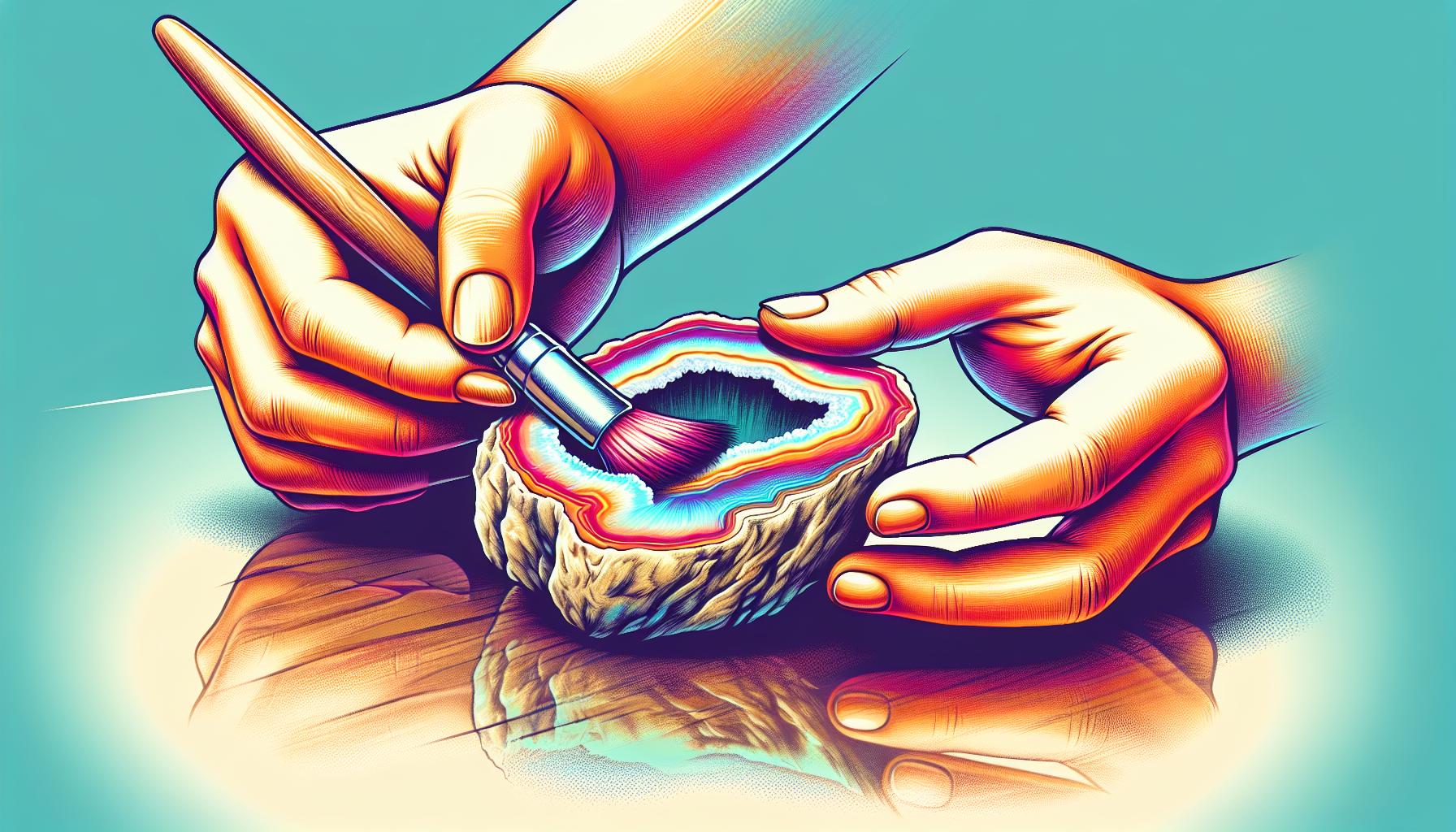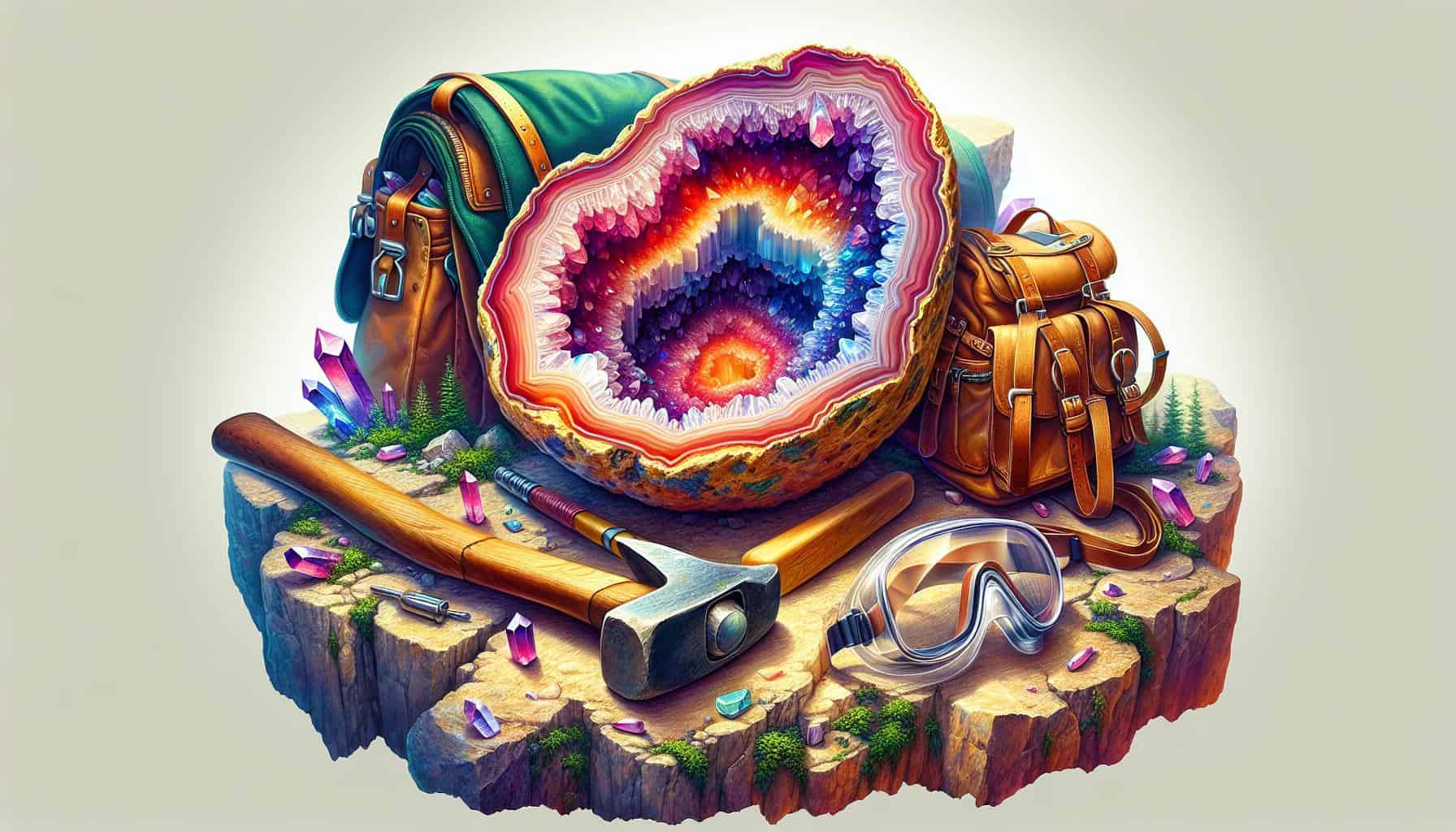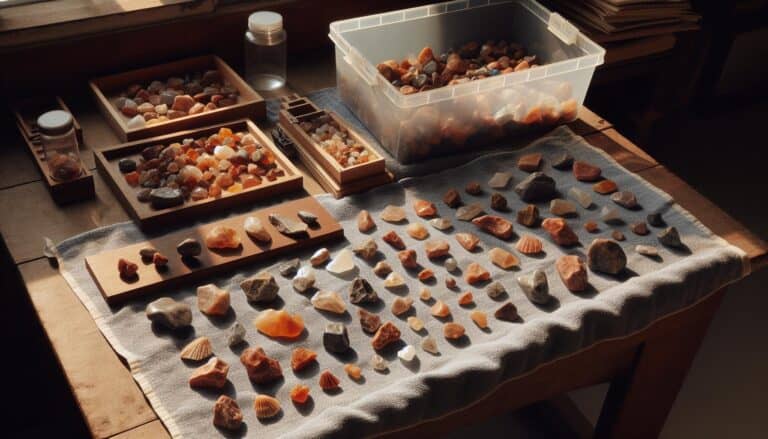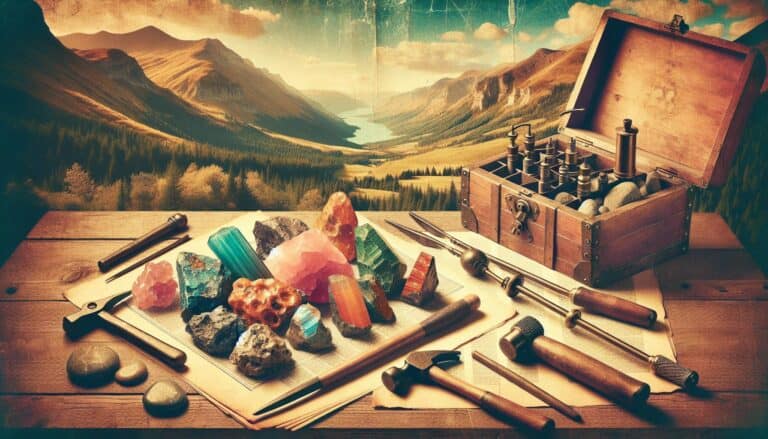Ever stumbled upon a rock that seemed ordinary at first glance but wondered if it might be hiding a world of crystals inside?
You’re not alone! Geodes are nature’s treasure chests, but spotting them can be tricky. Don’t worry; you’re about to learn how to identify a geode with ease.
Knowing what to look for is key. Geodes have unique characteristics that set them apart from other rocks.
Get ready to transform your outdoor adventures into a crystal quest as you gain the eye of a seasoned geode hunter.
Spot geodes: round, bumpy, light, hollow sound. Test with streak, magnet, hardness. Look for double refraction and translucency. Find in deserts, volcanic areas, near limestone. Prepare, prioritize safety, handle with care. Round, light, crystals are key!
How to Identify Geode Through Testing
Visual Inspection
You can often identify geodes by a careful visual inspection. Look for rocks with a rounded shape and a bumpy surface texture. True geodes typically have a hollow cavity, so they may feel lighter than they appear. Additionally, search for rocks that have a lumpy exterior which often signals the potential for crystals inside. Keep an eye out for tiny holes or cavities on the surface; these can be indicators of a geode.
The Streak Test
Your geode identification quest should include the streak test. To perform this, you’ll need an unglazed porcelain tile. Simply drag your rock across the tile and examine the color of the streak it leaves behind. Geodes will often leave a white streak, but the color may vary based on the minerals inside.
Magnet Test
You might wonder how a magnet can help with geode hunting. By running a strong magnet along the potential geode, you’re checking for any iron content. Most geodes aren’t magnetic, so if your rock is drawn to the magnet, it’s likely not a geode.
Hardness Test
Test the hardness of your rock. Geodes are relatively durable on the Mohs hardness scale, ranging from about 6.5 to 7.5. Try scratching it with a steel file – if the rock is softer and gets easily scratched, it’s probably not a geode.
Birefringence Test
Birefringence is a telltale feature in geode identification. This occurs when a material has two different refractive indexes. You’ll need polarized lenses for this; if you notice color changes or doubling of the structures inside your rock under light, your specimen might just be a geode.
Checking The Diaphaneity
Diaphaneity refers to the transparency or translucency of the rock. Hold your rock up to a light source. If light penetrates it, even slightly, it could indicate the presence of crystals inside, which is characteristic of geodes.
Single or Double Refraction
By examining the way light bends as it passes through your potential geode, you can determine if it exhibits single or double refraction. Most crystal structures within a geode will cause double refraction, making them stand out when backlit.
Refractive Index Test
Specialized equipment like a refractometer can assess the refractive index, providing clues about the minerals inside a geode. If the refractive index differs from that of ordinary rocks, you could be holding a geode.
Finding The Specific Gravity
Comparing the rock’s weight to the weight of an equal volume of water can reveal its specific gravity. Geodes have a specific gravity that’s different from ordinary rocks due to their crystal-filled cavities. This test may require specialized scales and water tanks.
Identifying Geodes in the Field
When you’re out exploring, identifying geodes can be as easy as noticing the place you find them. They’re often located in deserts, volcanic ash beds, or areas with limestone deposits. A geode’s typically round shape and lighter weight for its size can also guide you in the field.
Recognizing Potential Geode Rocks
Not all rocks that meet the initial criteria are geodes. However, if you find a rock with the following characteristics, it has the potential to be a geode:
- Hollow or lighter than expected for their size
- Spherical or egg-like in shape
- Contains mineral crystal formations
- Found in geologically favorable locations
Track down these gems by being attentive to these clues during your expeditions. Remember, patience and practice are key to becoming adept in the enthralling world of geode identification.
Physical Characteristics of Geodes

When you’re on the hunt for geodes, knowing the key physical characteristics can make or break your success. Round or oval shapes are the most telling signs of geodes and you’ll often find them in sizes ranging from an inch to several feet in diameter. The outer surface may be coarsely textured, resembling cauliflower heads, which is indicative of the mineral deposits within.
The weight of a geode is another giveaway. Although they might look hefty, geodes are usually lighter than they appear due to the hollow cavity inside. If you’re picking up rocks of similar size but one is noticeably lighter, it’s a good candidate for being a geode.
On the inside, geodes dazzle with an array of crystal formations. The colors vary widely based on the minerals present—from quartz’s clear shine to the deep purples of amethyst. Some may contain multiple hues, while others impress with a single, striking color.
Hints of brilliance peeking through fissures or cracks can also signal the presence of a geode. Such features invite a closer look, as they often lead to the breathtaking crystal-lined cavity that makes geodes coveted by collectors.
Remember to use your senses as well as these visual cues. Tapping a suspected geode can yield a hollow sound, different from the thud of a solid rock. Trust your instincts and experience, and with each find, you’ll refine your ability to spot these geological treasures.
How Are Geode Formed?
Geodes begin their life as bubbles in volcanic rock or as animal burrows, tree roots, or voids in sedimentary rock. Over millions of years, groundwater seeps into these cavities, carrying with it a bounty of minerals. As the water evaporates, it leaves behind a layer of minerals. This process repeats countless times, gradually creating a lining of crystals within the hollow chamber.
Mineral-rich water is the key ingredient in geode formation. The type of minerals in the water determines the kind of crystals that will form within the geode. Commonly found minerals include quartz, amethyst, and calcite.
Environmental conditions, such as temperature and pressure, play a crucial role in crystal size and formation. Steady conditions allow crystals to form slowly, resulting in larger, more well-defined crystals, while more erratic conditions can lead to smaller, less uniform crystals.
- Quartz crystals tend to form under cooler conditions
- Amethyst, a type of quartz, requires traces of iron and a specific range of radiation from the surrounding rock
- Calcite forms more rapidly and often creates the outermost layer of crystal within a geode
The layers and banding often seen in cut or broken geodes tell a geological story, recording the changes in conditions and mineral content that occurred during its formation. So next time you hold a geode, remember you’re holding a piece of Earth’s history formed over aeons.
Preparation for Geode Hunting
Before you set out on your adventure to find these geological treasures, it’s crucial to be well-prepared. This preparation involves gathering the right equipment and ensuring you’ve considered all necessary safety measures. By taking these steps, you’ll increase your chances of a successful geode-hunting trip and make sure the experience is as enjoyable and safe as possible.
Gathering the Right Tools
To maximize your chance of finding geodes, you’ll need a set of specific tools:
- Rock hammer or geologist’s pick: These are essential for breaking rocks to reveal potential geodes.
- Safety glasses: Protecting your eyes from flying rock fragments is non-negotiable.
- Gloves: Durable gloves will safeguard your hands during digging and chiseling.
- Sturdy footwear: Hiking boots or steel-toe shoes will provide the necessary protection and support across rough terrain.
- Small shovel or trowel: Useful for digging in areas where geodes may be partially buried.
- Bucket or backpack: To carry any potential finds back home without damaging them.
- Chisel and sledgehammer: For carefully splitting open found specimens.
Each tool serves a purpose, so equip yourself accordingly to improve your efficiency and capability during the hunt.
Safety Considerations
When planning your geode hunt, your safety should be a top priority. Remember these crucial points:
- Weather: Check the forecast before heading out, and plan according to avoid being caught in hazardous conditions.
- Terrain knowledge: Familiarize yourself with the area and any potential risks, such as wildlife or unstable ground.
- Communication: Ensure you have a way to communicate in case of emergencies, especially in remote locations where cell service may be spotty.
- First-Aid kit: Always have a basic first-aid kit on hand for minor injuries.
- Tell someone: Let a friend or family member know your plans, including where you’re going and when you expect to return.
Taking these steps seriously will help prevent accidents and make your geode-hunting trip safer and more enjoyable. Don’t underestimate the importance of preparation—your discoveries depend on it, and so does your well-being.
Handling and Care of Found Geode

Once you’ve successfully located and unearthed a geode, you’ll want to ensure that it’s handled with care to maintain its natural beauty and intricacy. Geodes are a marvel to behold, yet their aesthetic can be diminished if not properly cleaned and stored.
Cleaning Geodes
After the thrill of the find, cleaning your geode is the next step. Dirt and debris are a common sight on freshly found geodes, but patience and gentle handling are key to revealing their true splendor. Start by removing loose dirt with a soft brush. If water is necessary, opt for a lukewarm soak and use a mild detergent if needed. Harsh chemicals should be avoided as they can damage the mineral crystals.
- Allow the geode to air dry completely before storing.
- Avoid using abrasive cleaning tools as they can scratch the geode’s surface.
Keep in mind that some geodes have water-soluble minerals; thus, minimal water exposure is paramount to avoid dissolving the crystals inside.
Storing Geodes
Proper storage of geodes is crucial in maintaining their condition. Variables such as humidity, temperature, and light can impact the appearance and integrity of geodes over time.
- Store geodes in a cool, dry place away from direct sunlight.
- Display cases that offer protection from dust and environmental factors are ideal.
- If handling is necessary, ensure your hands are clean and free from oils and lotions that may transfer to the geode.
Wrap each geode in a soft cloth or place it in an individual container or compartment to prevent them from knocking against each other, potentially causing chips or cracks. If your geode still has a brittle outer shell, additional padding might be warranted to provide extra protection against physical stress during storage.
Conclusion: Confirming a Geode is Real
Now that you’ve got the scoop on geode formation and the essentials for a successful hunt, you’re all set to explore and uncover these natural treasures.
Remember, the thrill of discovery is just the beginning. Once you’ve found your geode, taking the time to properly clean and store your new gem will ensure it keeps its sparkle for years to come. So grab your gear, stay safe, and enjoy the adventure that awaits in the great outdoors.
Happy geode hunting!







